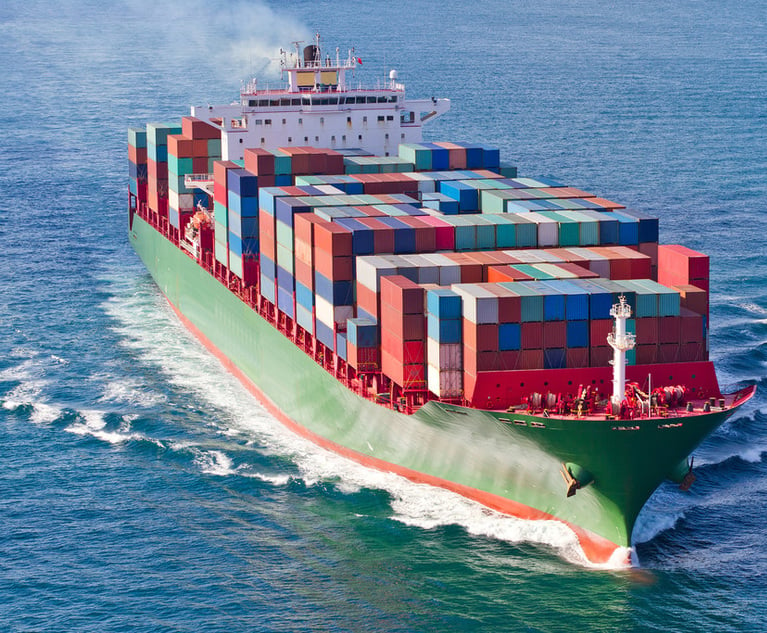 Credit: Photo Gallery/Adobe Stock
Credit: Photo Gallery/Adobe Stock Maritime Law Column: Hurricanes and Their Cost on the Maritime Industry
"As you might expect, hurricanes create delays in vessel movements and time is money. Who pays for the delays encountered?" writes columnist Keith Letourneau.
July 02, 2024 at 12:30 PM
6 minute read
Cargo and ShippingAside from the destruction that flows from it, how does a hurricane along the Gulf Coast affect the maritime industry that operates hundreds of terminals and moves thousands of ocean-going ships and inland tows along its waterways?
With the approach of a hurricane, the U.S. Coast Guard Captain of the Port will begin setting various port conditions advising the public and industry of the storm's anticipated landfall. Once the port condition reaches category Zulu, no further vessel movements are permitted within the port. By that time, marine terminal operators will have shut down operations and ordered vessels to depart their berths, and ocean-going vessels will have left the port to evade or ride out the storm because such vessels are safer underway than they are moored or anchored. Inland towboats and barges will also move to alternative safe harbors via the intracoastal waterway or inland rivers if time permits. Those that remain hunker down at barge fleeting areas, where extra tiedowns are employed and tugboats often standby to provide extra power to keep the barge fleets intact.
This content has been archived. It is available through our partners, LexisNexis® and Bloomberg Law.
To view this content, please continue to their sites.
Not a Lexis Subscriber?
Subscribe Now
Not a Bloomberg Law Subscriber?
Subscribe Now
NOT FOR REPRINT
© 2025 ALM Global, LLC, All Rights Reserved. Request academic re-use from www.copyright.com. All other uses, submit a request to [email protected]. For more information visit Asset & Logo Licensing.
You Might Like
View All
Maritime Law Column: When Is a Contract Maritime and Why Is That Important?
7 minute read
Maritime Law Column: Texas Maritime Public Infrastructure Projects to Watch
6 minute read
Trending Stories
- 1Insurers in Crosshairs After Police-Brutality Judgment
- 2Reed Smith Opening Atlanta Office With 37 Lawyers From Two Firms
- 3Coerced Confessions and the Burden of Proof Beyond Reasonable Doubt
- 4Attorneys ‘On the Move’: O’Melveny Hires Former NBA Vice President; MoFo Adds Venture Capital Partner
- 5'Skin in the Game': Lawyers Call for Pressure After American Airlines Crash
Who Got The Work
J. Brugh Lower of Gibbons has entered an appearance for industrial equipment supplier Devco Corporation in a pending trademark infringement lawsuit. The suit, accusing the defendant of selling knock-off Graco products, was filed Dec. 18 in New Jersey District Court by Rivkin Radler on behalf of Graco Inc. and Graco Minnesota. The case, assigned to U.S. District Judge Zahid N. Quraishi, is 3:24-cv-11294, Graco Inc. et al v. Devco Corporation.
Who Got The Work
Rebecca Maller-Stein and Kent A. Yalowitz of Arnold & Porter Kaye Scholer have entered their appearances for Hanaco Venture Capital and its executives, Lior Prosor and David Frankel, in a pending securities lawsuit. The action, filed on Dec. 24 in New York Southern District Court by Zell, Aron & Co. on behalf of Goldeneye Advisors, accuses the defendants of negligently and fraudulently managing the plaintiff's $1 million investment. The case, assigned to U.S. District Judge Vernon S. Broderick, is 1:24-cv-09918, Goldeneye Advisors, LLC v. Hanaco Venture Capital, Ltd. et al.
Who Got The Work
Attorneys from A&O Shearman has stepped in as defense counsel for Toronto-Dominion Bank and other defendants in a pending securities class action. The suit, filed Dec. 11 in New York Southern District Court by Bleichmar Fonti & Auld, accuses the defendants of concealing the bank's 'pervasive' deficiencies in regards to its compliance with the Bank Secrecy Act and the quality of its anti-money laundering controls. The case, assigned to U.S. District Judge Arun Subramanian, is 1:24-cv-09445, Gonzalez v. The Toronto-Dominion Bank et al.
Who Got The Work
Crown Castle International, a Pennsylvania company providing shared communications infrastructure, has turned to Luke D. Wolf of Gordon Rees Scully Mansukhani to fend off a pending breach-of-contract lawsuit. The court action, filed Nov. 25 in Michigan Eastern District Court by Hooper Hathaway PC on behalf of The Town Residences LLC, accuses Crown Castle of failing to transfer approximately $30,000 in utility payments from T-Mobile in breach of a roof-top lease and assignment agreement. The case, assigned to U.S. District Judge Susan K. Declercq, is 2:24-cv-13131, The Town Residences LLC v. T-Mobile US, Inc. et al.
Who Got The Work
Wilfred P. Coronato and Daniel M. Schwartz of McCarter & English have stepped in as defense counsel to Electrolux Home Products Inc. in a pending product liability lawsuit. The court action, filed Nov. 26 in New York Eastern District Court by Poulos Lopiccolo PC and Nagel Rice LLP on behalf of David Stern, alleges that the defendant's refrigerators’ drawers and shelving repeatedly break and fall apart within months after purchase. The case, assigned to U.S. District Judge Joan M. Azrack, is 2:24-cv-08204, Stern v. Electrolux Home Products, Inc.
Featured Firms
Law Offices of Gary Martin Hays & Associates, P.C.
(470) 294-1674
Law Offices of Mark E. Salomone
(857) 444-6468
Smith & Hassler
(713) 739-1250







